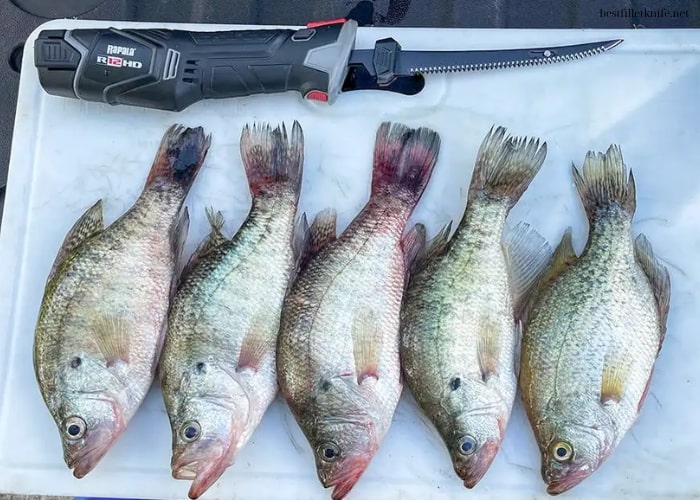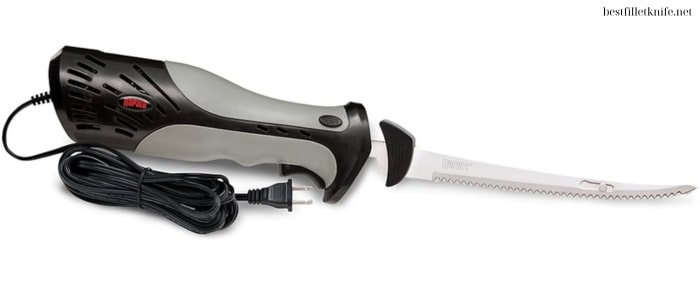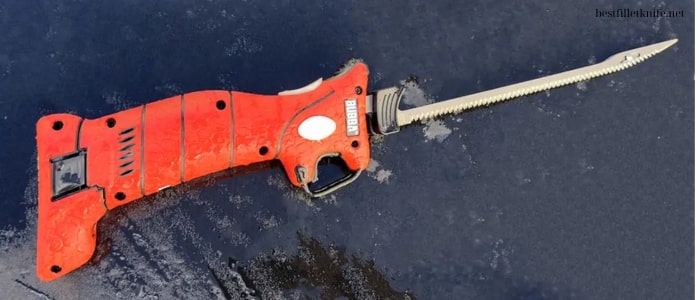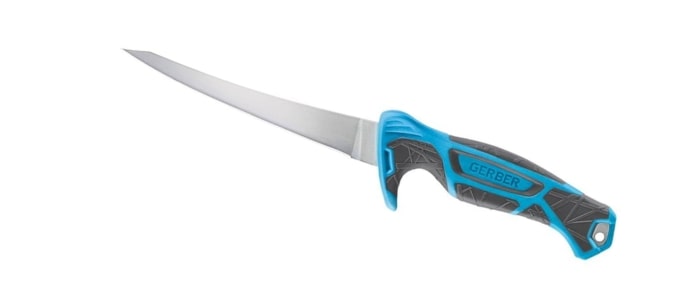My primary objective when fishing is to bring back a meal. If you share this objective, you’ll need a fillet knife to transform your catch from water to table. You can choose from simple fillet knives with wooden or plastic handles to modern electric fillet knives that make the job quick and efficient. With so many excellent fillet knives available, it can be challenging to narrow down the options. To make it easier, I tested the best fillet knives on both freshwater and saltwater fish to find the ones that best meet your fish cleaning needs.
Best Overall Fillet Knife and Cordless Lithium Fillet Knife: Rapala R12 Heavy Duty Lithium Ion
The Best Corded Electric Fillet Knife Kit: Rapala Heavy Duty Electric Fillet Knife
Best Quiet Electric Fillet Knife: BUBBA Li-Ion Cordless Electric Fillet Knife
The Best Folding Fillet Knife: Opinel Slim Series Fillet Folding Knifes
Best Budget Fillet Knife: Little Cook 6-inch Fillet Knife
Best Fixed Blade Fillet Knife: Gerber Gear Controller

Best Overall Fillet Knife and Cordless Lithium Fillet Knife: Rapala R12 Heavy Duty Lithium Ion
We have tested many electric fillet knives, both corded and cordless, including the latest lithium options that offer longer cutting times, fewer recharging cycles, and sustained cutting power for extended durability. In our opinion, the Rapala R12 Heavy Duty Lithium Fillet Knife is the best available. It boasts a long run time on a single charge, allowing me to go weeks without recharging during peak fish cleaning seasons. Over the past two years, I have used the Rapala R12 HD knife to clean thousands of crappies and bluegills, and it continues to perform exceptionally well.
Pros
- Fast blade speed
- Spare battery
- Excellent blade shape and flexibility
- The best torque of any cordless fillet knife
- Good HD blades
- Works with previous Rapala blades
- Long use cycle on single charge
Cons
- A bit louder than some other cordless
- . Only one blade style

The Best Corded Electric Fillet Knife Kit: Rapala Heavy Duty Electric Fillet Knife
The Rapala Heavy Duty Electric Fillet Knife is one of the standout products from the Rapala brand, renowned for its fishing gear and seafood preparation tools. This electric fillet knife is specially designed to make filleting fish quicker and more efficient. It is highly regarded for its durability, powerful performance, and convenient design, making it suitable for both amateur and professional users.
Pros:
- Powerful performance
- High durability
- Sharp stainless steel blade
- Convenient ergonomic design
- Easy to use
Cons:
- Requires an electrical power source.
- Heavier than regular fillet knives

Best Quiet Electric Fillet Knife: BUBBA Li-Ion Cordless Electric Fillet Knife
We have tested numerous electric fillet knives, both corded and cordless, and more recently, those with lithium batteries that offer longer cutting times, fewer recharging cycles, and sustained clean cutting power. In our opinion, the Rapala R12 Heavy Duty Lithium Fillet Knife is currently the best on the market. It boasts an extended run time on a single charge; I can go weeks without needing to recharge during peak fish cleaning seasons. Over the past two years, I have cleaned thousands of crappie and bluegills with the Rapala R12 HD knife, and it’s still performing exceptionally well.
Pros:
- Long-lasting lithium-ion battery
- Cordless convenience
- Sharp, durable blades
- Comfortable, non-slip grip
- Multiple blade options are included.
Cons:
- Requires recharging
- Heavier than some other models
- Can be noisy during operation.

The Best Folding Fillet Knife: Opinel Slim Series Fillet Folding Knifes
The Opinel Slim Series, also known as the Effie’s line of folding fillet knives, offers an elegant solution for filleting fish. These knives feature blades made from Sandvik 12C27 stainless steel, which resists rust and corrosion and can be easily resharpened and maintained with natural oils. The real wood handles are both stylish and ergonomic, and they can be easily folded and carried in a pocket or bag. Additionally, the unique Vibrolock locking ring provides a distinctive locking mechanism that ensures the knife remains rigid during use.
Pros:
- Elegant design
- Rust-resistant Sandvik 12C27 stainless steel blade
- Easy to sharpen and maintain
- Stylish and ergonomic wood handle
- Compact and portable
- Unique Vibrolock locking mechanism
Cons:
- Manual sharpening is required.
- Wood handles may require more maintenance.
- Limited blade-length options

Best Fixed Blade Fillet Knife: Gerber Gear Controller
At first, I was quite impressed with the shape and texture of the Controller 8’s handle. It took a minute to get used to the finger grooves on the handle, but once I did, it felt really good. The blade left a smooth cut in the flesh of some large red snappers. The ergonomic handle allows you to keep a steady hand no matter how much fish slime and water accumulate on the knife. The Gerber Controller knife is designed to endure harsh saltwater conditions, featuring enhanced corrosion-resistant protection.
Pros:
- Corrosion-resistant stainless steel blade
- Comfortable, ergonomic handle
- Non-slip grip
- Includes a sheath for safe storage.
- Ideal for saltwater environments
- Long 8-inch blade for versatility
Cons:
- Heavier compared to some other fillet knives
- The blade may require frequent sharpening.
What to Look for in a Good Fish Fillet Knife
When choosing a good fillet knife for cleaning fish, there are several key features to consider. Let’s go through these to help you determine which knife is best suited for your needs.
Blade Length: This is one of the most important aspects of a fish fillet knife. You don’t want to use an overly long knife for small fish or a short knife for large, broad fish, as it makes filleting cumbersome. Blades that are 5 to 7 inches long are ideal for panfish and small bass, while 8 to 12 inch blades are better suited for larger freshwater species like walleye, salmon, catfish, and striped bass. While we typically use a 9-inch blade to clean crappie, it’s primarily due to the height of a 2-pound crappie, where a longer blade proves beneficial. Essentially, shorter blades are better for smaller fish, and longer blades are better for taller fish.
Flexibility: This is a double-edged sword when filleting fish, pun intended. You want a flexible knife to make precise cuts along bones and around rib cages. However, you need a sturdy blade to cut through tougher skin, scales, and bones. For larger fish with tougher skin, a less flexible knife is preferable, while for smaller fish with thinner skin, a more flexible blade is ideal. This is why many electric and fixed-blade knives opt for a moderately flexible blade.
Blade Design: The blade design can greatly aid in filleting fish. Stainless steel blades are very popular for fish filleting due to their resistance to rust and corrosion. Since you’re often cutting and holding the knife in wet conditions, a rust-resistant blade is essential. This is also why many fillet knives have coated blades. Additionally, fillet knives are not typically used as kitchen utensils for cleaning fish. The best fillet knife I own is actually in my kitchen, and I never cut fish with it because the blade isn’t made of rust-resistant material. So, I clean and dry it immediately after each use.
Electric and Fixed Blades: Electric knives have become very popular, especially with the advent of lithium power. You no longer need a super portable knife to quickly and easily fill a pile of fish. While I still believe a fixed blade can extract more meat from fish, an electric knife can turn the task of cleaning 40 crappies into 20 minutes of work instead of an hour. However, I still use both fixed and folding knives occasionally. With a fixed blade, I can extract every bit of meat from a small fish, whereas an electric knife might waste a bit more due to the speed and sawing action. So, it’s a matter of speed versus maximizing meat utilization.